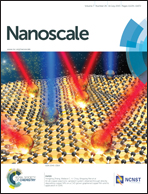Ultra-durable rotary micromotors assembled from nanoentities by electric fields†
Abstract
Recently, we reported an innovative type of micromotors consisting of nanowires as rotors and patterned Au/Ni/Cr nanodisks as bearings. The dimensions of micromotors were less than 1 μm, and could continuously rotate for 15 hours over 240 000 cycles. To understand the limitation of their lifetime, we systematically investigated the rotation dynamics by analytical modeling and determined the time-dependent torques and forces involved in the rotation. From the forces and torques, the extent of wear of micromotors was successfully derived, which agreed well with the experimental characterization. The results also proved that the frictional force linearly increases with the loading in such rotary nanodevices operating in suspension, consistent with the prediction of the non-adhesive multi-asperity friction theory. With these understandings, we enhanced the design of micromotors and achieved an operation lifetime of 80 hours and over 1.1 million total rotation cycles. This research, shedding new light on the frictional mechanism of recently reported nanowire micromotors with demonstration of the most durable rotary nanomechanical devices of similar dimensions to the best of our knowledge, can be inspiring for innovative design of future nanomechanical devices with ultra-long lifetime for practical applications.


 Please wait while we load your content...
Please wait while we load your content...